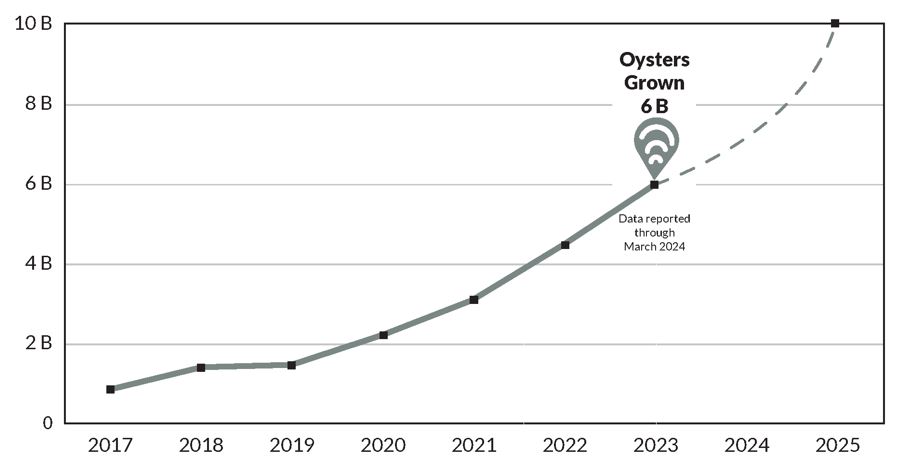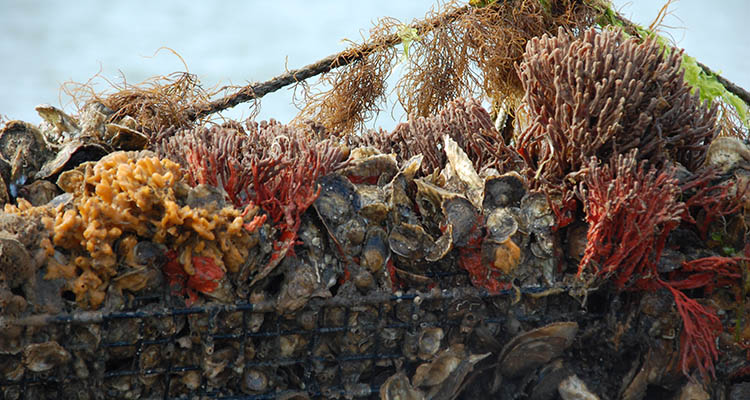What is the Chesapeake Oyster Alliance?
The Chesapeake Oyster Alliance (COA) is a coalition of organizations across Maryland and Virginia supporting the ambitious goal of adding 10 Billion new oysters to Chesapeake Bay waters by 2025. While each COA Partner contributes to the expansion of oyster populations in their own way, as a broad coalition we work together to increase restoration efforts, ensure science-based fishery management, promote innovative oyster research, affect oyster-positive policy at the local, state and federal levels, and support the oyster aquaculture industry.
Chesapeake Oyster Alliance initiatives drive improvements in water quality, engage new constituencies, and highlight economic benefits across the region as we accelerate ongoing oyster recovery efforts in the Chesapeake Bay. For it is only with a healthy Chesapeake oyster population that a restored Bay is possible.
Who is involved in the Chesapeake Oyster Alliance?
A diverse group of partners have committed to making the Chesapeake Oyster Alliance goal a reality. These partners include oyster growers, non-profits, academic institutions, private companies, and more. Each COA Partner brings something unique to this effort. We are always recruiting and accepting suggestions for new partners in the Chesapeake Oyster Alliance. Please see the current membership of this unique coalition on our Partners page.
How does this alliance differ from existing oyster restoration efforts?
In recent years, recovery of Chesapeake Bay oyster populations has been accelerating due to state and federal agencies' large-scale efforts to restore 10 tributaries along with improvements in water quality, increasing disease resistance, growth of aquaculture on leased bottom, and scientific management of wild harvest. But without an ambitious, collaborative effort like the Chesapeake Oyster Alliance, we will likely fall short of truly restoring this keystone species. By generating new partnerships and sparking innovation, this coalition will accelerate efforts that already show tremendous promise for the Bay's oyster populations, while also bringing new partners and approaches to this rapidly evolving field.
Benefits of COA Partnership include a deep network and press opportunities to promote and share Partners' work, eligibility to apply for the Chesapeake Oyster Innovation Award Program and Restoration Capacity Assistance Fund, attend and present at the Chesapeake Oyster Science Symposium and our spring/fall COA Partner meetings, and much more. We also invite all Partners to help guide the coalition by joining one or more of our five committees: Steering, Policy, Science, Outreach and Implementation.
Where will the 10 billion oysters come from?
The 10 billion oysters will come primarily from large-scale restoration efforts in Maryland and Virginia that support the Chesapeake Bay Program objective of restoring 10 tributaries by 2025, but will also include oysters planted in the aquaculture industry and wild fishery.
Every oyster counts! We also track each oyster from participating oyster gardening programs Bay-wide, smaller-scale projects by COA Partner organizations like shoreline and reef-ball/reef-castle projects, and other miscellaneous efforts. Much of the large-scale restoration work taking place will not be counted toward our goal until those sites are monitored three years after installation to account for mortality or growth. That is where we expect to see major increases in oyster population.
Progress

The methodology and forecasting for our 10 billion goal is scientifically based and conservative. Much of the large-scale restoration work taking place will not be counted toward our goal until those sites are monitored three years after installation to account for mortality or growth. That is where we expect to see the major increases observable in the forecasting portion of this graph. However, those numbers are forecast at minimum standards. In some areas, we may see significant accumulation beyond those minimum expectations. Overall, we continue to track to meet our goal of 10 billion oysters by 2025.
What are the key components of the Chesapeake Oyster Alliance?
- Restoring Oysters in Sanctuaries
Experience, adaptive management, and cutting-edge science are teaching us more about restoration every year, but the task is huge. At present, the largest contribution to restoration efforts comes from tributary-scale projects undertaken by state and federal agencies in support of Chesapeake Bay Program oyster restoration goals. We must continue to support these restoration efforts while developing opportunities to improve and expand. Not only will we rebuild habitat and water filtration capacity, but restored sanctuary reefs will produce oyster larvae to disperse to harvest bars as well as sanctuaries. - Improving Science-Based Fishery Management
Because more than 75 percent of the Bay's oyster bottom is open to commercial harvest, good management of these reefs represents a significant opportunity to recover the Bay's oyster population. Rotational harvest holds promise for stability in the fishery, but its success will depend on harvesters, packers, scientists, and managers working together. Science-based management should be employed with a goal of substantially increasing the number of oysters on public bars. It will be particularly important to devise a funding system that can make critical, strategic, up-front investments in bottom rehabilitation and spat-on-shell planting that will make the industry self-supporting and profitable in the long-term. - Increasing Oyster Aquaculture
Aquaculture provides a unique opportunity to support economic growth in coastal communities while providing sustainable seafood and water quality benefits. Aquaculture in Virginia has grown rapidly in recent years and Maryland's fledging industry is beginning to grow as well. The Chesapeake Oyster Alliance will support the continued growth of these industries to provide economic development opportunities, enhance water quality in the Bay, reduce fishing effort on wild oyster stocks, and provide novel structured habitat for commercial and recreational fishes.
